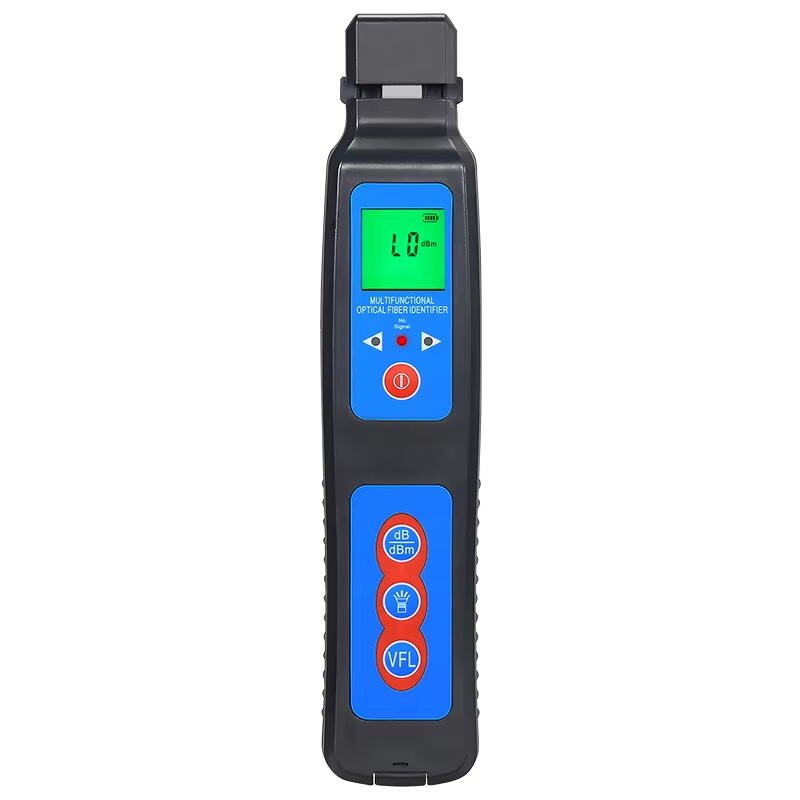Understanding Fiber Identifiers in Fiber Optic Networks
Fiber identifiers play a vital role in fiber optic networks by helping techs tell apart different fibers without messing up the network traffic. Basically, these gadgets pick up on the light signals moving through the cables so workers can spot which ones are active without pulling anything out or stopping data from flowing. For anyone who's worked on live networks knows how important this is when doing repairs or diagnostics. It means services stay online while specific fibers get checked and fixed as needed. The ability to work on individual strands without shutting down everything else saves time and money for companies relying on constant connectivity across their operations.
Fiber identifiers really shine during maintenance work when they cut down on network downtime significantly. Research indicates that implementing these identifiers can slash downtime by around half, which makes a huge difference in how efficiently operations run day to day. Technicians find it much easier to spot active fibers without guesswork, so problems get fixed faster and services stay online longer. Network performance improves across the board because of this. For anyone running fiber optic systems today, having good fiber identifiers isn't just helpful it's practically essential for keeping everything running smoothly without constant disruptions.
Key Functions of a Fiber Identifier for Fiber Optic Network Maintenance
Signal detection works differently in active fibers compared to regular ones, and this capability lies at the heart of how fiber identifiers operate. Basically, these tools spot signals by picking up tiny fluctuations in light levels moving through fiber optic cables. This approach turns out to be really helpful when trying to catch problems before they become serious issues. Industry stats show that catching faults early on cuts down maintenance expenses while making systems run smoother overall. For companies running big networks, this kind of proactive monitoring makes all the difference between smooth operations and costly downtime.
Keeping services running while identifying network components remains a key concern for technicians working on fiber systems. With fiber identifiers, techs can spot which fibers are actively transmitting data without cutting off the signal entirely. Most companies follow this approach as part of standard maintenance protocols, and according to field reports, there haven't been any noticeable service interruptions when using these methods properly. For today's high-speed networks, this kind of uninterrupted operation matters a lot. When businesses need their connections to stay online 24/7, even small outages can cause major headaches both operationally and from a customer perspective standpoint.
Getting the right location information matters a lot when dealing with complicated network situations, especially when working with multiple fiber installations. Take a look at dense networks packed with lots of different fibers. Finding exactly which one we're talking about becomes really important. The problem gets even worse inside big data centers or telecom networks where all those fibers run right next to each other. Mix them up and things start going wrong fast. That's why fiber identifiers exist. They cut through all that confusion so network managers don't spend hours trying to figure out which cable goes where. Makes life much easier for everyone involved.
Benefits of Using a Fiber Identifier in Network Maintenance
Fiber Identifiers significantly enhance troubleshooting capabilities, enabling quicker response times during network outages. For instance, several telecommunications companies have reported reduced outage durations through the use of Fiber Identifiers, which quickly pinpoint problematic fibers without disrupting ongoing services. This swift identification process minimizes downtime and improves overall service efficiency.
Fiber identifiers really boost maintenance efficiency, which makes them worth considering for any installation project. Studies show that technicians save quite a bit of time when installing or fixing fiber networks because these tools make it much easier to spot and confirm active fibers. Instead of spending hours manually checking connections, maintenance crews get things done faster. The time saved isn't just theoretical either many field workers report cutting down their workload by almost half when working with proper fiber identification equipment.
When working on fiber optic networks, safety should never be an afterthought, and Fiber Identifiers make all the difference when it comes to cutting down on risks from manual inspection work and those pesky workplace accidents we all want to avoid. These handy tools eliminate the need to actually touch fibers while checking if services are still running smoothly, which means fewer chances of damaging delicate strands or causing injuries to workers. Most tech companies have started adopting Fiber Identifiers as part of their standard safety protocols because they just plain work better than older methods. After all, nobody wants to deal with downtime caused by preventable mishaps.
Implementing Fiber Identifiers in Operational Settings
Getting Fiber Identifiers working properly on site requires sticking to some basic best practices. Calibration needs regular attention to keep readings accurate when spotting live fibers, which cuts down on mistakes during those frustrating network checks. Training matters too. Techs should know their way around whatever model they're handling day to day. Most companies find that well-trained staff spot issues faster and avoid damaging expensive gear. The payoff? More reliable network testing results for sure, but there's another bonus nobody talks about much these days – properly maintained Fiber Identifiers just last longer between replacements, saving money over time.
When Fiber Identifiers get paired up with standard network maintenance equipment, they really step up game in terms of how well networks perform and stay dependable. Organizations find great value when these identifiers work alongside things like Optical Time Domain Reflectometers (those OTDR devices everyone knows about) and regular network analyzers. Putting all this together creates something resembling a complete toolbox for looking at what's going on across entire networks. The big plus here is catching problems before they become major headaches, which means fewer surprises down the road. Tech teams who combine Fiber Identifiers with their existing gear tend to spot issues faster and fix them without wasting time hunting around blind. Maintenance becomes smoother overall because technicians have better information right from the start instead of guessing where trouble might be hiding.
Conclusion: The Future of Fiber Identifiers in Network Maintenance
Fiber optic tech is changing fast these days, mainly because automation and AI keep getting built into how we manage networks. We're seeing a big move toward smarter networks that can basically run themselves while still delivering top performance without needing constant human oversight. A lot of this has to do with machine learning becoming more common in things like optical performance monitoring. Network operators need systems that can handle massive data volumes and adjust on the fly, so they're turning to AI tools for continuous monitoring and quick fixes when problems pop up in their fiber infrastructure. Some companies have already reported cutting down maintenance costs by over 30% after implementing these smart monitoring systems.
Fiber identification tools are set for major changes in the coming years according to many industry insiders. Most analysts believe these new tools won't just get better at spotting fibers accurately, they'll actually work much better alongside current network setups. Big tech companies have poured millions into R&D lately, aiming to develop systems that do more than fix problems after they happen. Some prototypes already show promise in detecting potential issues days before they cause real trouble for network operators. What makes this possible? A lot of it comes down to partnerships forming between top tech firms and universities across the country. These collaborations bring together different kinds of knowledge that simply weren't available before, helping push forward what fiber identifiers can actually accomplish in real world situations.
FAQ
What is a Fiber Identifier?
A Fiber Identifier is a tool used in fiber optic networks to identify and manage individual fibers without disrupting network traffic by detecting optical signals in the fibers.
How does a Fiber Identifier work?
Fiber Identifiers work by capturing minute changes in light intensity in active fibers, allowing technicians to identify specific live fibers without interrupting signal transmission.
Why are Fiber Identifiers important?
Fiber Identifiers are crucial as they help minimize network downtime, maintain service continuity, and reduce maintenance costs, enhancing overall network performance and reliability.
Can Fiber Identifiers reduce network maintenance risks?
Yes, they play a critical role in reducing risks, as they remove the need for direct fiber handling during service checks, lowering the chance of fiber damage or personal injury.
What advancements are expected in Fiber Identifier technology?
Future advancements are expected to improve their accuracy, integrate with network infrastructures, and use AI-driven solutions for predictive issue prevention and real-time monitoring.
Table of Contents
- Understanding Fiber Identifiers in Fiber Optic Networks
- Key Functions of a Fiber Identifier for Fiber Optic Network Maintenance
- Benefits of Using a Fiber Identifier in Network Maintenance
- Implementing Fiber Identifiers in Operational Settings
- Conclusion: The Future of Fiber Identifiers in Network Maintenance
- FAQ







